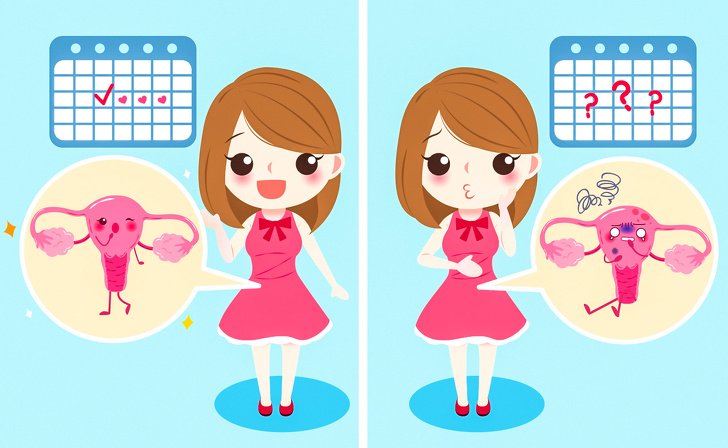Right before our period we start looking at the calendar and worrying about whether our period is going to be alright and on time. And mid-cycle bleeding can make us panic.
6. Should I worry if my “schedule” isn’t always on time?
No. All women are different. A cycle can go from 21 to 35 days. Also, a woman might notice changes in her schedule: this month a period comes earlier, next month it arrives later.
It’s the same with the periods length. Generally, most women’s periods last from about 4 to 7 days, beginning with light spotting, then the flow gets heavier, and then gets gradually lighter.
5. How to distinguish your period from just spotting?

First, period blood is dark red and contains the particles of the mucous membranes lining the uterine cavity (endometrium). Spotting refers to very light brown discharge that occurs between menstrual periods. As a rule, this discharge isn’t dangerous.
Doctors don’t treat light discharge that occurs during ovulation as a pathological issue. It happens because of a drop in estrogen which is the female sex hormone. By the way, some women can feel ovulation and they experience pain in the lower abdomen a few days before or after ovulation.
4. When is it recommended to see a doctor when it comes to bleeding between periods?

All irregular bleeding may indicate that something’s wrong.
It’s very important for women to pay attention to discharge after ovulation during the luteal phase. The yellow body, a temporary endocrine structure, appears and starts to produce progesterone.
This hormone restores the endometrium and makes pregnancy possible in females. If the level of progesterone is low, irregular bleeding can occur.
Visit a doctor when bleeding caused by improper birth control dosage occurs or if you experience pain in the lower abdomen accompanied by a fever.
Hormonal failure may also cause sudden bleeding. Visit a doctor if you don’t take birth control but intermenstrual discharge still occurs on the same days of your cycle. In most cases, estrogen deficiency is the main reason.
3. What is the connection between birth control pills and a fake period?

Many people think that when you stop taking birth control, on your 7 day break, you will get a normal period.
In actuality, it’s so-called withdrawal bleeding or a fake period. It’s shorter than a regular period, less painful, and bleeding isn’t that heavy. A regular period can occur only after a woman quits taking birth control. It takes from 6 to 12 months to restore a normal menstrual cycle.
2. Can bleeding indicate that you’re pregnant?

Yes. Implantation bleeding can occur a few days after conception when a fertilized egg attaches to the lining of the uterus and slightly damages the vessels. By the way, the amount may be really small — just a couple of drops. That’s why the process usually remains unnoticed.
Features that can distinguish a regular period from implantation bleeding:
- blood color is bright red (menstrual blood is darker);
- bleeding lasts no longer than 2 days and doesn’t get heavier in the middle;
- the process isn’t painful.
1. What do you do if contact bleeding occurs?

As you can probably tell from the name, this bleeding occurs during contact like sexual intercourse or a physical exam. The blood is bright red in this case.
If the damage isn’t severe, contact bleeding won’t last long. But if it doesn’t stop, you should contact a doctor immediately. An examination is also needed if contact bleeding occurs on a regular basis.
Was this article useful for you? What other advice can you share?


